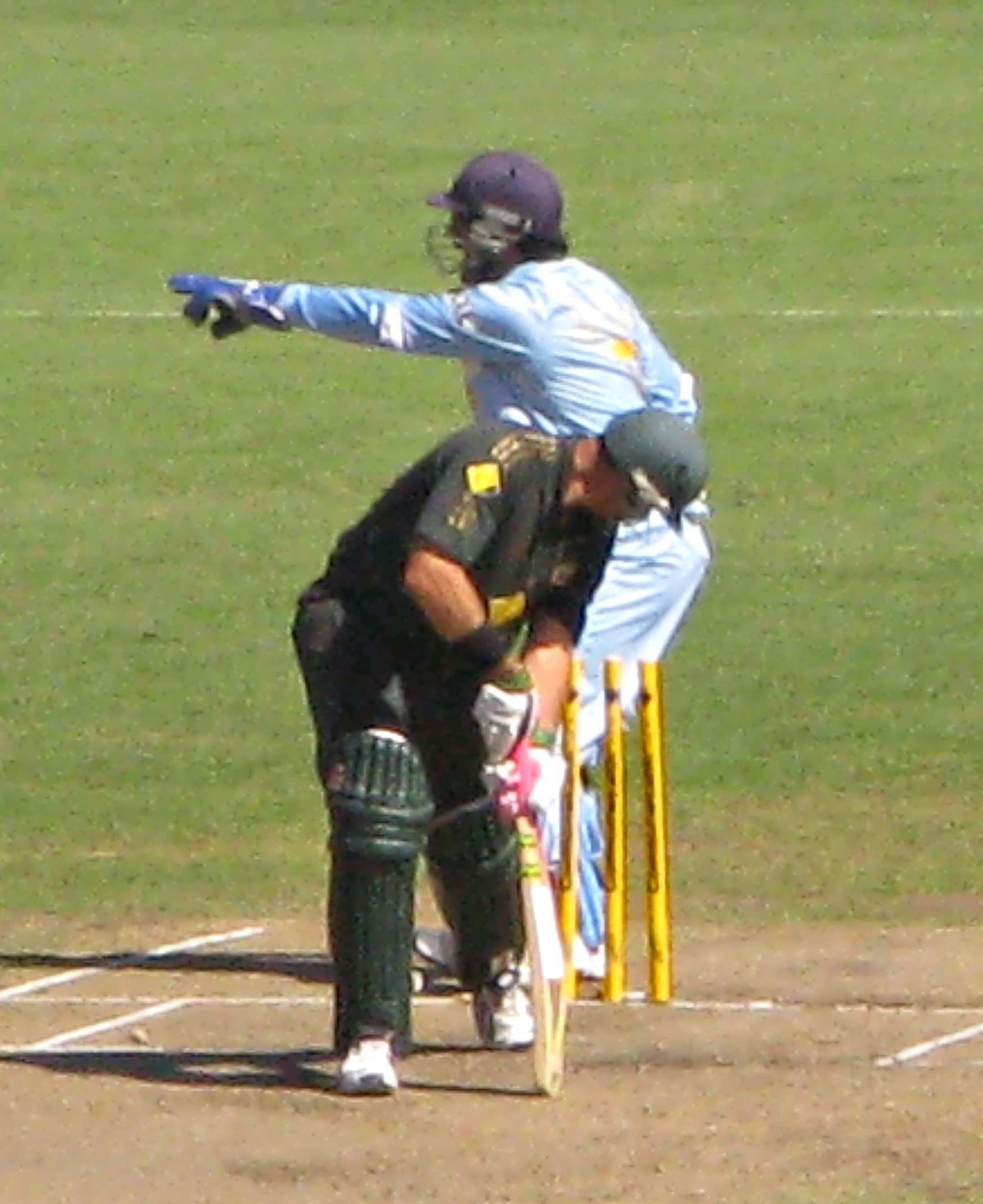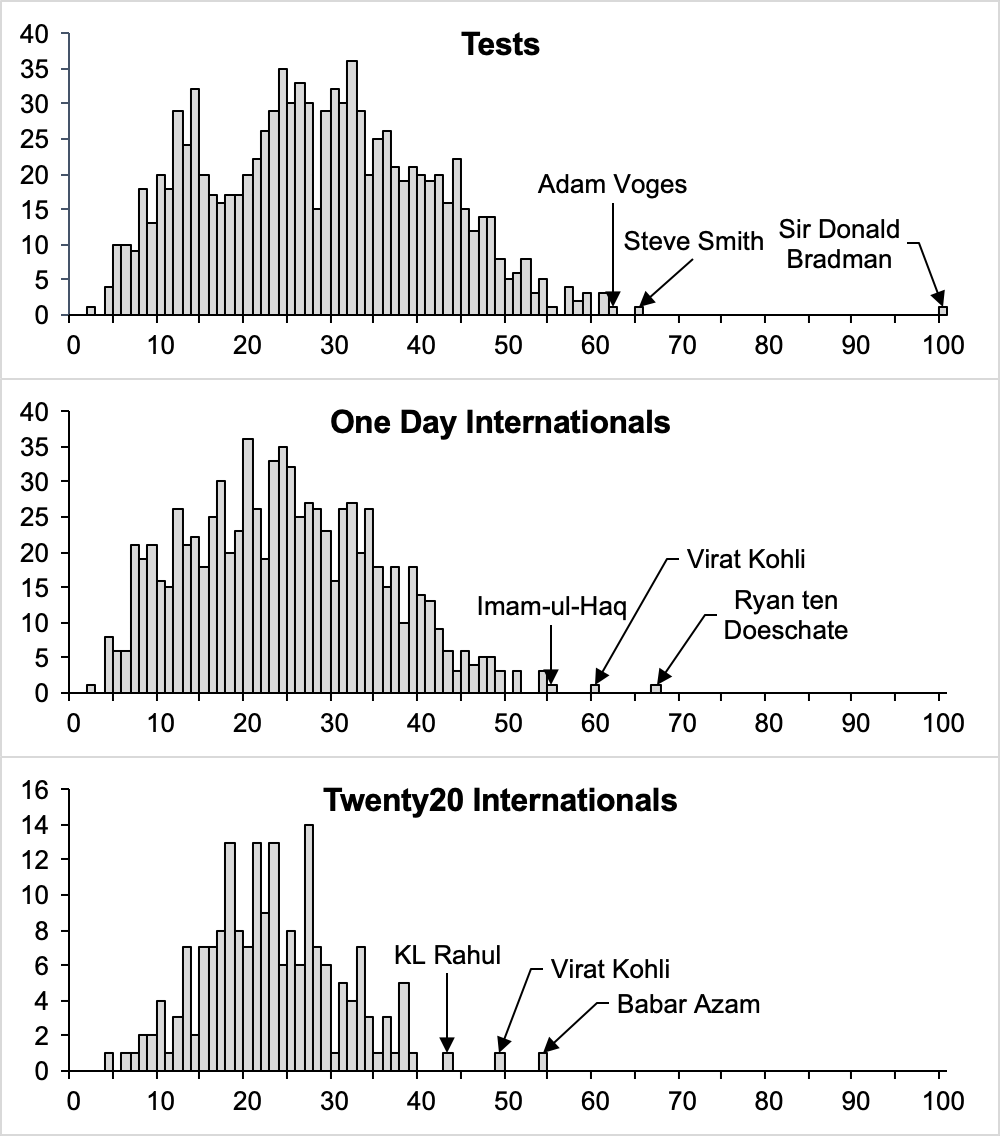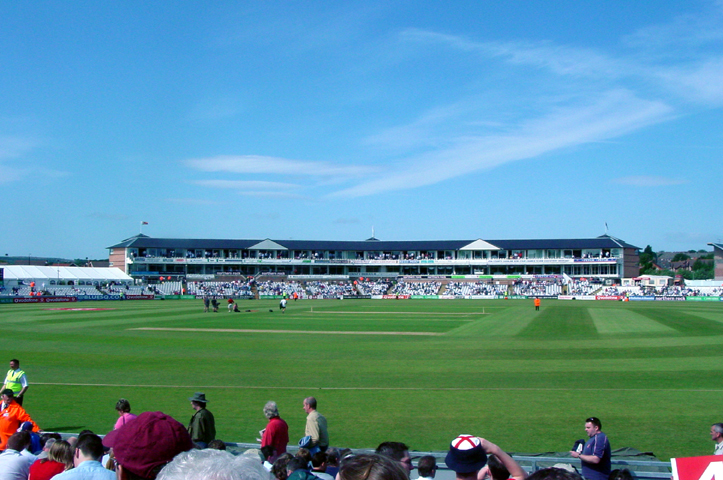|
Steven Bramhall
Steven Bramhall (born 26 November 1967) is a former English cricketer. Bramhall was a right-handed batsman who fielded as a wicket-keeper. He was born in Warrington, Lancashire. Bramhall made his debut in county cricket for Cheshire in the 1988 Minor Counties Championship final against Cambridgeshire, having played Second XI cricket for the Worcestershire Second XI prior to that. He played Minor counties cricket for Cheshire from 1989 to 1991, playing in both the Minor Counties Championship and MCCA Knockout Trophy. In the 1990 County Championship, Bramhall made his first-class debut for Lancashire against Northamptonshire. He played one further first-class match that season for Lancashire, against the touring Sri Lankans. He next appeared in first-class cricket in 1992, when he joined Nottinghamshire. It was in this season that he made his debut in List A cricket against Durham in the Sunday League. Bramhall played for Nottinghamshire in the 1992 and 1993 seasons, playing t ... [...More Info...] [...Related Items...] OR: [Wikipedia] [Google] [Baidu] |
Warrington
Warrington () is a town and unparished area in the Borough of Warrington, borough of the same name in the ceremonial county of Cheshire, England, on the banks of the River Mersey. It is east of Liverpool, and west of Manchester. The population in 2019 was estimated at 165,456 for the town's urban area, and just over 210,014 for the entire borough, the latter being more than double that of 1968 when it became a New towns in the United Kingdom, new town. Warrington is the largest town in the ceremonial county of Cheshire. In 2011 the unparished area had a population of 58,871. Warrington was founded by the Roman Empire, Romans at an important crossing place on the River Mersey. A new settlement was established by the Saxons, Saxon Wærings. By the Middle Ages, Warrington had emerged as a market town at the lowest bridging point of the river. A local tradition of textile and tool production dates from this time. The town of Warrington (north of the Mersey) is within the bounda ... [...More Info...] [...Related Items...] OR: [Wikipedia] [Google] [Baidu] |
County Championship
The County Championship (referred to as the LV= Insurance County Championship for sponsorship reasons) is the domestic first-class cricket competition in England and Wales and is organised by the England and Wales Cricket Board (ECB). It became an official title in 1890. The competition consists of eighteen clubs named after, and representing historic counties, seventeen from England and one from Wales. The earliest known inter-county match was played in 1709. Until 1889, the concept of an unofficial county championship existed whereby various claims would be made by or on behalf of a particular club as the "Champion County", an archaic term which now has the specific meaning of a claimant for the unofficial title prior to 1890. In contrast, the term "County Champions" applies in common parlance to a team that has won the official title. The most usual means of claiming the unofficial title was by popular or press acclaim. In the majority of cases, the claim or proclamation ... [...More Info...] [...Related Items...] OR: [Wikipedia] [Google] [Baidu] |
Essex County Cricket Club
Essex County Cricket Club is one of eighteen first-class county clubs within the domestic cricket structure of England and Wales. It represents the historic county of Essex. Founded in 1876, the club had minor county status until 1894 when it was promoted to first-class status pending its entry into the County Championship in 1895, since then the team has played in every top-level domestic cricket competition in England. Essex currently play all their home games at the County Cricket Ground, Chelmsford. The club has formerly used other venues throughout the county including Lower Castle Park in Colchester, Valentines Park in Ilford, Leyton Cricket Ground, the Gidea Park Sports Ground in Romford, and Garon Park and Southchurch Park, both in Southend. Its limited overs team is called the Essex Eagles. Honours First XI honours * County Championship (8) – 1979, 1983, 1984, 1986, 1991, 1992, 2017, 2019 :''Division Two'' (3) – 2002, 2016, 2021 * Sunday/Pro 40 Le ... [...More Info...] [...Related Items...] OR: [Wikipedia] [Google] [Baidu] |
1994 NatWest Trophy
The 1994 NatWest Trophy was the 14th NatWest Trophy. It was an English limited overs county cricket tournament which was held between 21 June and 3 September 1994. The tournament was won by Worcestershire County Cricket Club who defeated Warwickshire County Cricket Club by 8 wickets in the final at Lord's. Format The 18 first-class counties, were joined by twelve Minor Counties: Bedfordshire, Berkshire, Cambridgeshire, Cheshire, Cumberland, Devon, Lincolnshire, Norfolk, Northumberland, Oxfordshire, Staffordshire and Wales Minor Counties. The Ireland national cricket team and the Scotland national cricket team also participated. Teams who won in the first round progressed to the second round. The winners in the second round then progressed to the quarter-final stage. Winners from the quarter-finals then progressed to the semi-finals from which the winners then went on to the final at Lord's Lord's Cricket Ground, commonly known as Lord's, is a cricket venue i ... [...More Info...] [...Related Items...] OR: [Wikipedia] [Google] [Baidu] |
1994 English Cricket Season
The 1994 English cricket season was the 95th in which the County Championship had been an official competition. A very strong Warwickshire team won both the Britannic Assurance County Championship and the Sunday League. England defeated New Zealand 1-0 and drew with South Africa 1–1 in the two Test series. Honours *County Championship - Warwickshire *NatWest Trophy - Worcestershire * Sunday League - Warwickshire *Benson & Hedges Cup - Warwickshire *Minor Counties Championship - Devon *MCCA Knockout Trophy - Devon *Second XI Championship - Somerset II *Wisden Cricketers of the Year - Brian Lara, Devon Malcolm, Tim Munton, Steve Rhodes, Kepler Wessels Test series England played New Zealand in a 3-test series, winning the first, and drawing the remaining two. South Africa toured England, playing three test matches winning one, drawing one and losing one. County Championship NatWest Trophy Benson & Hedges Cup Sunday League Leading batsmen J D Carr topped the batt ... [...More Info...] [...Related Items...] OR: [Wikipedia] [Google] [Baidu] |
Stumping
Stumped is a method of dismissing a batsman in cricket, which involves the wicket-keeper putting down the wicket while the batsman is out of his ground. (The batsman leaves his ground when he has moved down the pitch beyond the popping crease, usually in an attempt to hit the ball). The action of stumping can only be performed by a wicket-keeper, and can only occur from a legitimate delivery (i.e. not a no-ball), while the batsman is not attempting a run; it is a special case of a run out. Being "out of his ground" is defined as not having any part of the batsman's body or his bat touching the ground behind the crease – i.e., if his bat is slightly elevated from the floor despite being behind the crease, or if his foot is on the crease line itself but not completely across it and touching the ground behind it, then he would be considered out (if stumped). One of the fielding team (such as the wicket-keeper himself) must appeal for the wicket by asking the umpire. The app ... [...More Info...] [...Related Items...] OR: [Wikipedia] [Google] [Baidu] |
Catch (cricket)
Caught is a method of dismissing a batsman in cricket. A batsman is out caught if the batsman hits the ball, from a legitimate delivery, with the bat, and the ball is caught by the bowler or a fielder before it hits the ground. If the ball hits the stumps after hitting the wicket-keeper, If the wicket-keeper fails to do this, the delivery is a "no ball", and the batsman cannot be stumped (nor run out, unless he attempts to run to the other wicket.) If the catch taken by the wicket-keeper,then informally it is known as caught behind or caught at the wicket. A catch by the bowler is known as caught and bowled. This has nothing to do with the dismissal bowled but is rather a shorthand for saying the catcher and bowler are the same player. (The scorecard annotation is usually ''c. and b.'' or ''c&b'' followed by the bowler's name.) Caught is the most common method of dismissal at higher levels of competition, accounting for 36,190 Test match dismissals between 1877 and 2012, ... [...More Info...] [...Related Items...] OR: [Wikipedia] [Google] [Baidu] |
Stump (cricket)
In cricket Cricket is a bat-and-ball game played between two teams of eleven players on a field at the centre of which is a pitch with a wicket at each end, each comprising two bails balanced on three stumps. The batting side scores runs by st ..., the stumps are the three vertical posts that support the bails and form the wicket. '' Stumping'' or ''being stumped'' is a method of dismissing a batsman. The umpire ''calling stumps'' means the play is over for the day. Part of the wicket The stumps are three vertical posts which support two bails. The stumps and bails are usually made of wood, most commonly ash, and together form a wicket at each end of the pitch. The overall width of each wicket is 9 inches (22.9 cm). Each stump is 28 inches (71.1 cm) tall with maximum and minimum diameters of 1 inches (3.81 cm) and 1 inches (3.49 cm). They have a spike at one end for inserting into the ground, and the other end has a U-shaped ... [...More Info...] [...Related Items...] OR: [Wikipedia] [Google] [Baidu] |
Batting Average (cricket)
In cricket, a player's batting average is the total number of runs they have scored divided by the number of times they have been out, usually given to two decimal places. Since the number of runs a player scores and how often they get out are primarily measures of their own playing ability, and largely independent of their teammates, batting average is a good metric for an individual player's skill as a batter (although the practice of drawing comparisons between players on this basis is not without criticism). The number is also simple to interpret intuitively. If all the batter's innings were completed (i.e. they were out every innings), this is the average number of runs they score per innings. If they did not complete all their innings (i.e. some innings they finished not out), this number is an estimate of the unknown average number of runs they score per innings. Each player normally has several batting averages, with a different figure calculated for each type of matc ... [...More Info...] [...Related Items...] OR: [Wikipedia] [Google] [Baidu] |
Sunday League (cricket)
The NatWest Pro40 League was a one-day cricket league for first-class cricket counties in England and Wales. It was inaugurated in 1999, but was essentially the old Sunday League retitled to reflect large numbers of matches being played on days other than Sunday. Sunday League The Sunday League was launched in 1969, as the second one-day competition in England and Wales alongside the Gillette Cup (launched in 1963). Sponsored by John Player & Sons, the league was called John Player's County League (1969), the John Player League (1970–83), then the John Player Special League (1984–86). The 17 counties of the time played each other in a league format on Sunday afternoons throughout the season. These matches were concise enough to be shown on television, with BBC2 broadcasting one match each week in full until 1980, and then as part of the '' Sunday Grandstand'' multi-sport programme. For close finishes for the title, cameras appeared at the grounds where the contenders for the ... [...More Info...] [...Related Items...] OR: [Wikipedia] [Google] [Baidu] |
Durham County Cricket Club
Durham County Cricket Club (rebranded as Durham Cricket in February 2019) is one of eighteen first-class cricket, first-class county cricket, county clubs within the domestic cricket structure of England and Wales. It represents the Historic counties of England, historic county of Durham. Founded in 1882, Durham held Minor counties of English and Welsh cricket, minor status for over a century and was a prominent member of the Minor Counties Championship, winning the competition seven times. In 1992, the club joined the County Championship and the team was elevated to senior status as an official first-class cricket, first-class team. Durham has been classified as an occasional List A team from 1964, then as a full List A team from 1992; and as a senior Twenty20 team since the format's introduction in 2003. Durham CCC competes in the County Championship, Specsavers County Championship, the Royal London One-Day Cup and in the North Group of the NatWest t20 Blast. They won the Coun ... [...More Info...] [...Related Items...] OR: [Wikipedia] [Google] [Baidu] |
1992 English Cricket Season
The 1992 English cricket season was the 93rd in which the County Championship had been an official competition. Essex won a second successive Britannic Assurance title. Durham entered the Championship for the first time. This was the first time that a new county had been admitted to the championship for 71 years since Glamorgan in 1921. Pakistan defeated England 2-1 in the Test series. Honours *County Championship - Essex *NatWest Trophy - Northamptonshire * Sunday League - Middlesex *Benson & Hedges Cup - Hampshire *Minor Counties Championship - Staffordshire *MCCA Knockout Trophy - Devon *Second XI Championship - Surrey II *Wisden - Nigel Briers, Martyn Moxon, Ian Salisbury, Alec Stewart, Wasim Akram Test series Pakistan tour County Championship NatWest Trophy Benson & Hedges Cup Sunday League Leading batsmen Leading bowlers References External links CricketArchive – season and tournament itineraries Annual reviews * Playfair Cricket Annual 1993 * Wi ... [...More Info...] [...Related Items...] OR: [Wikipedia] [Google] [Baidu] |




